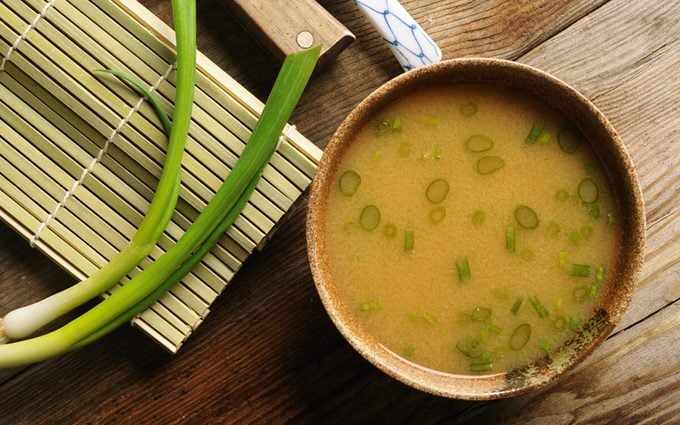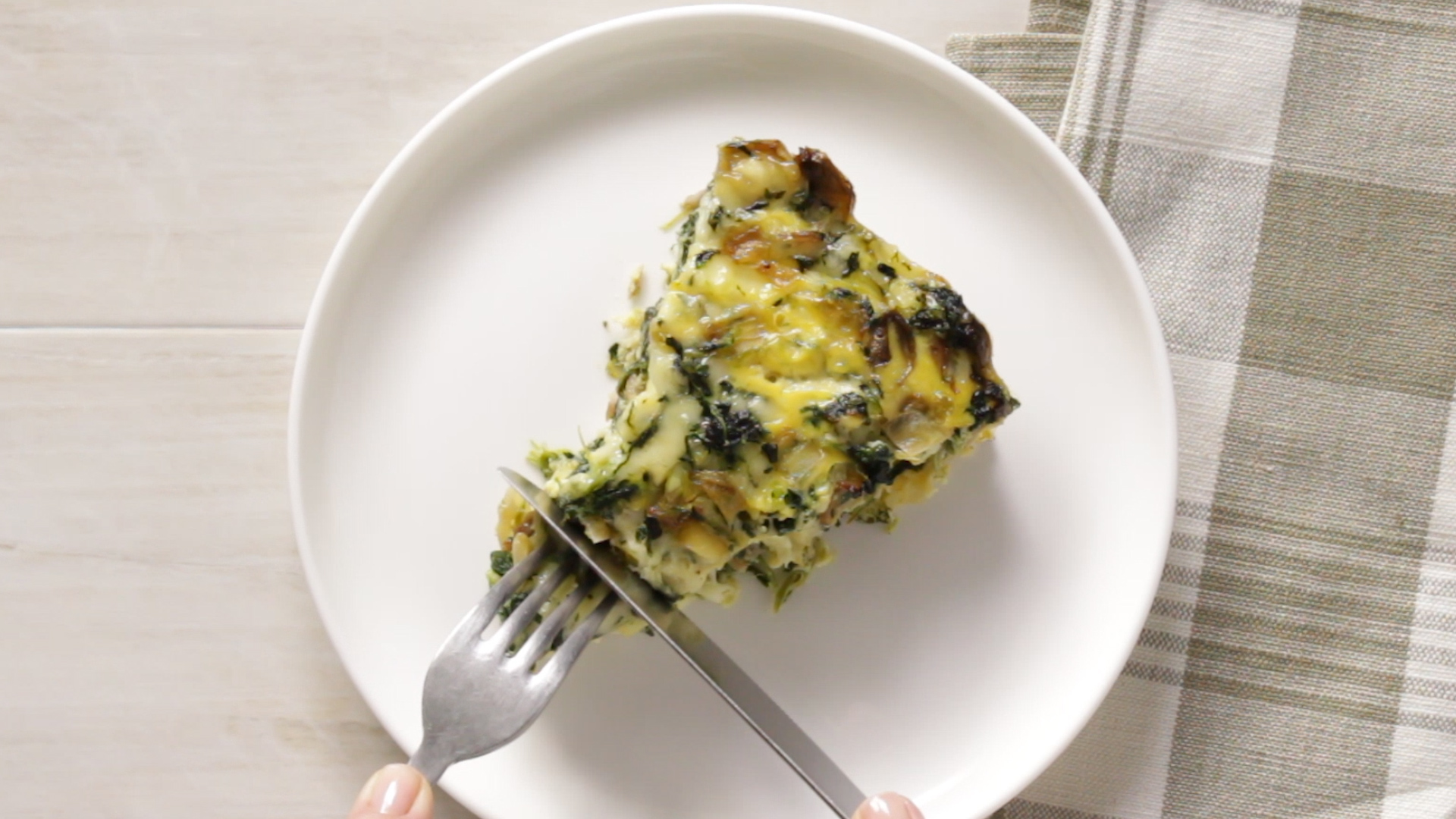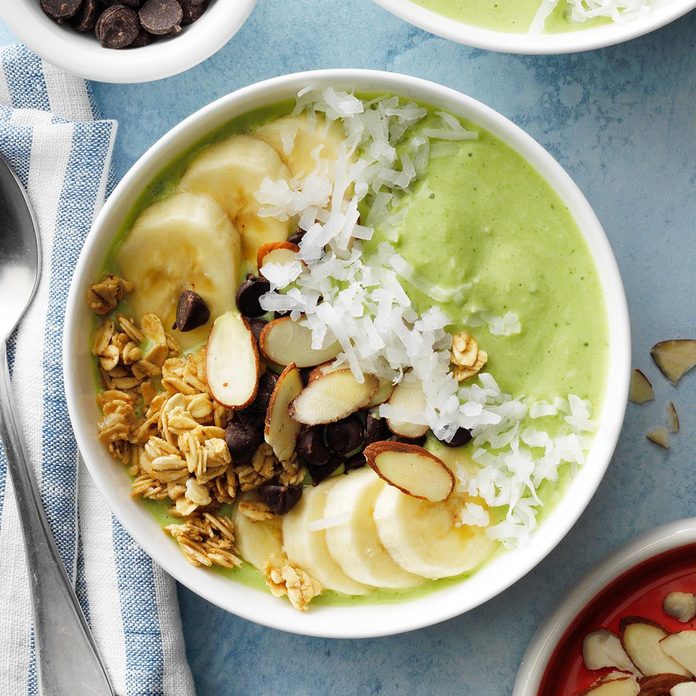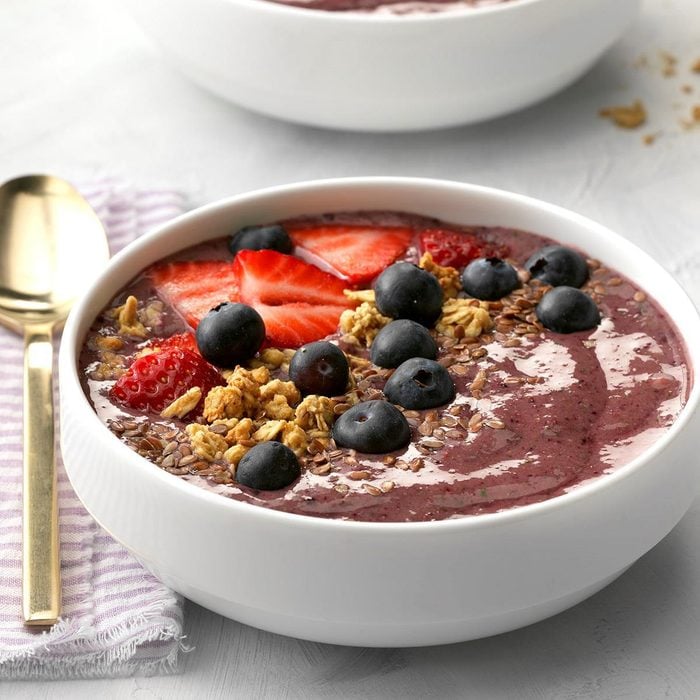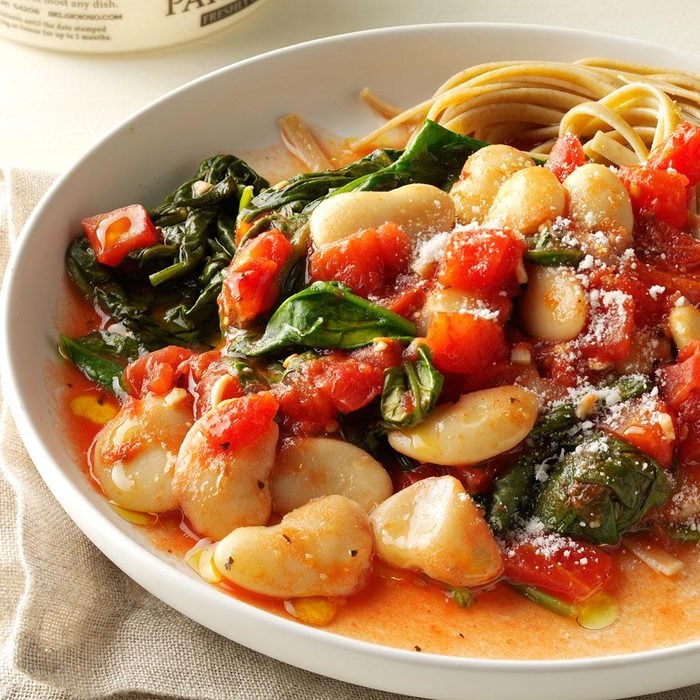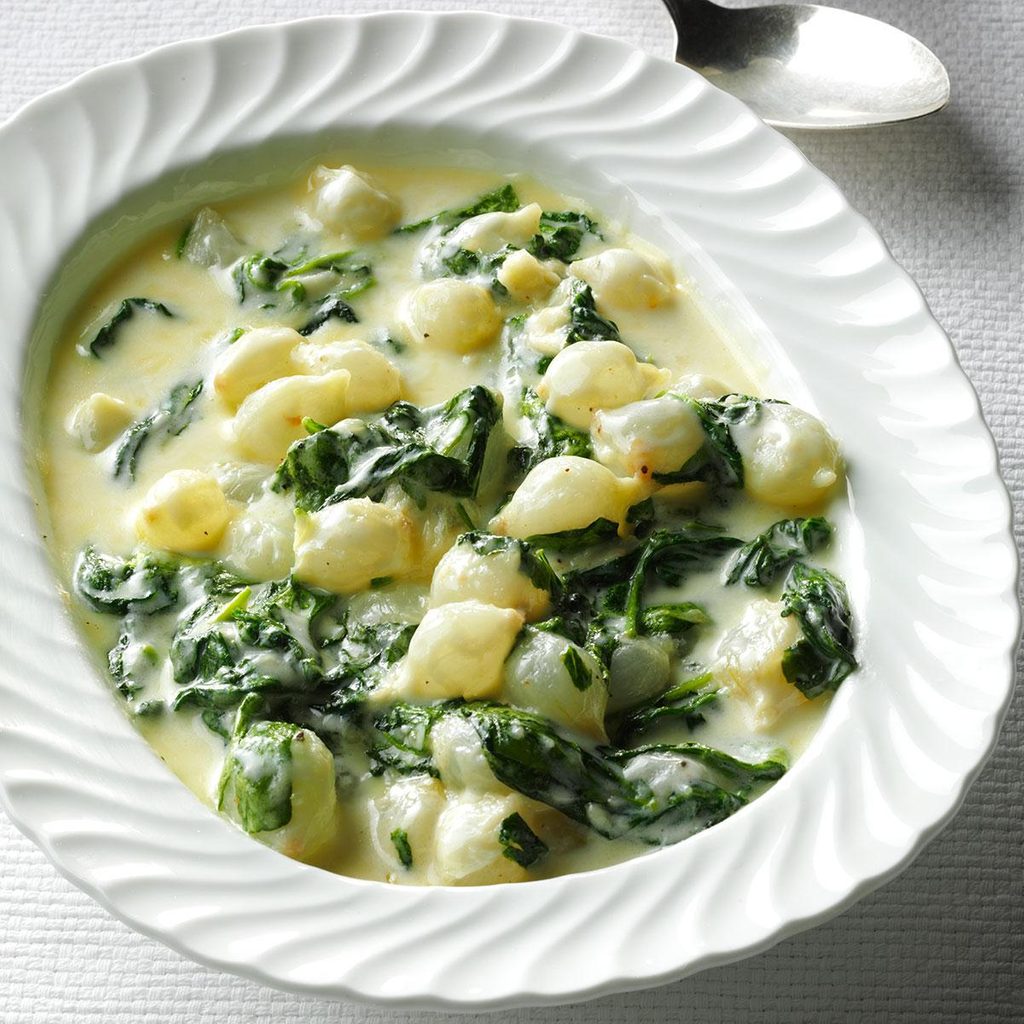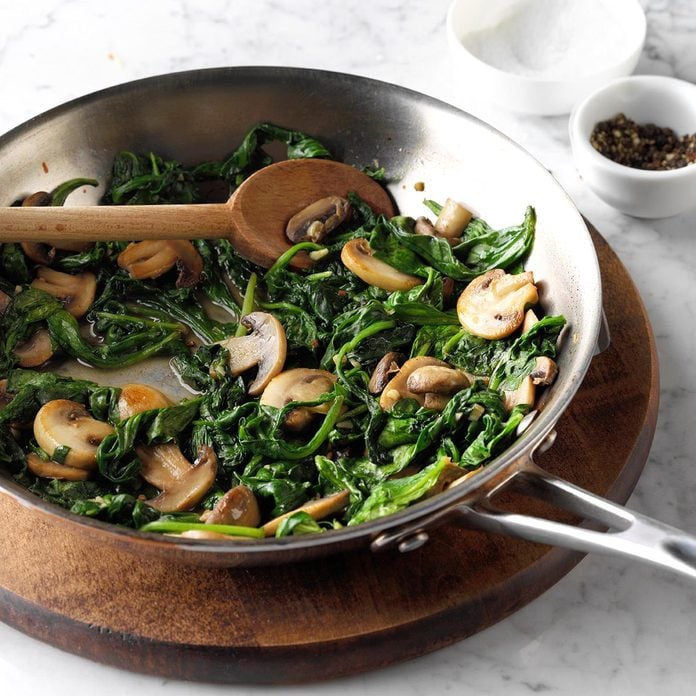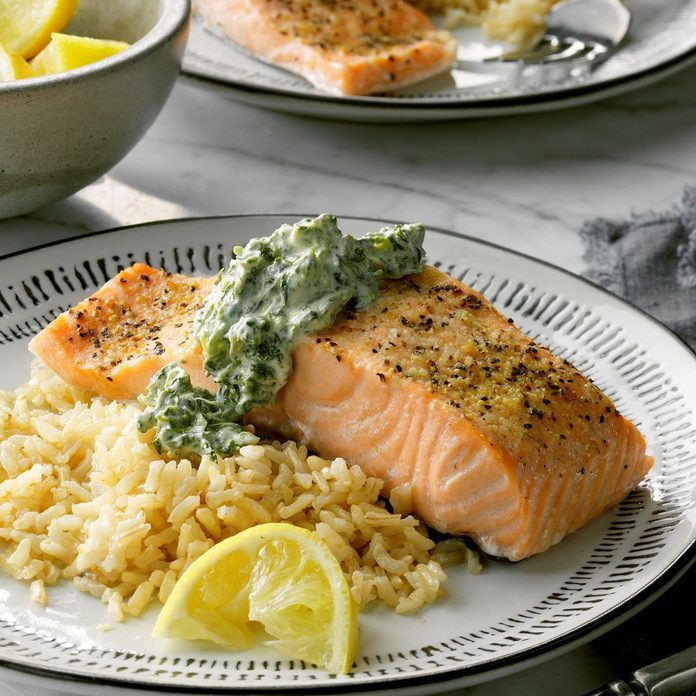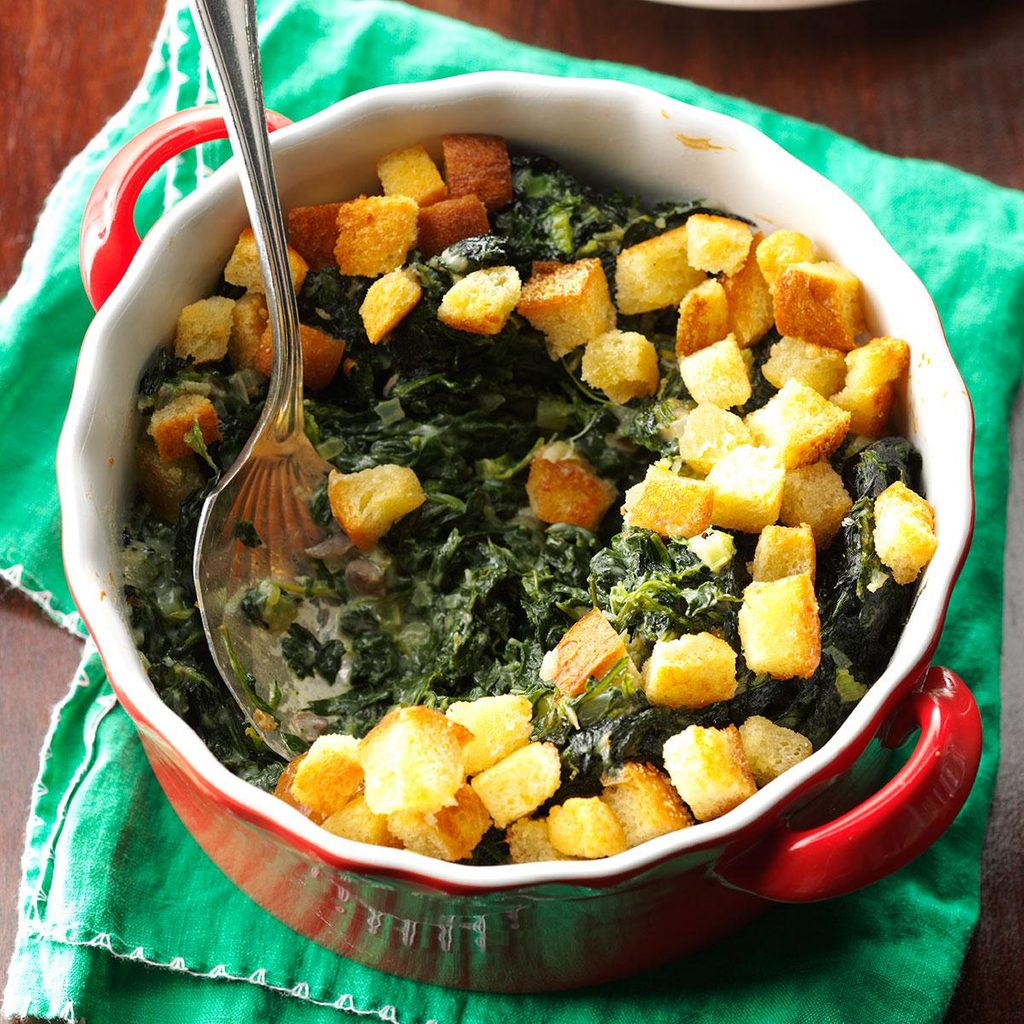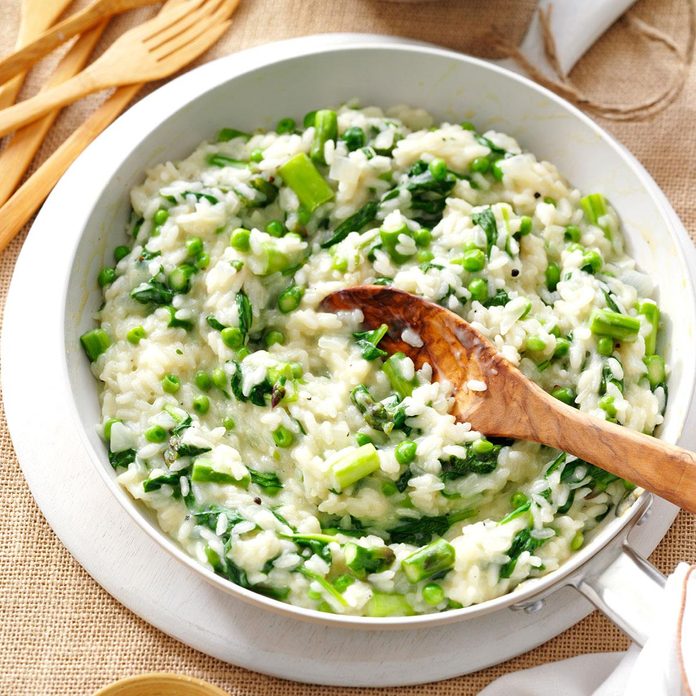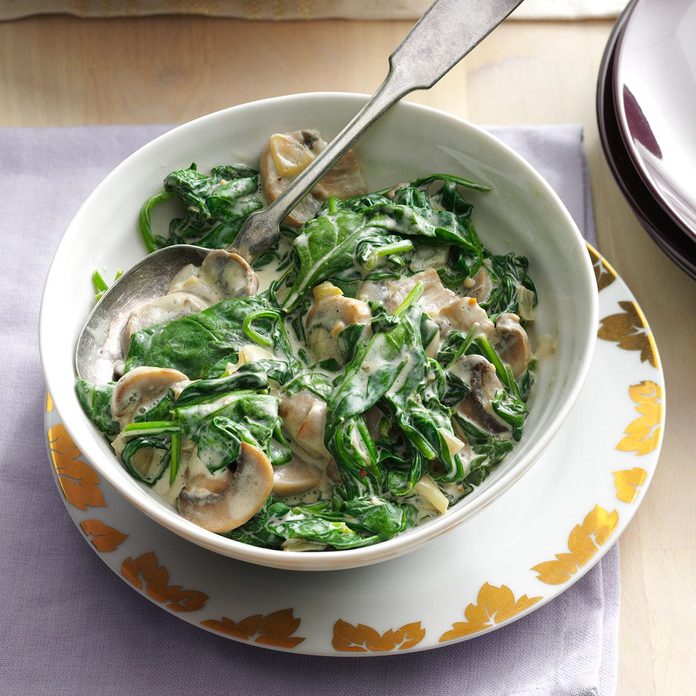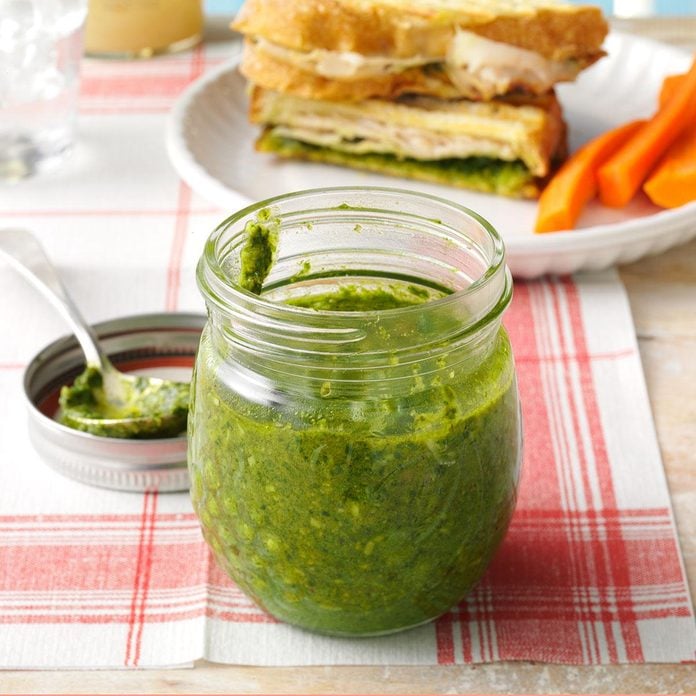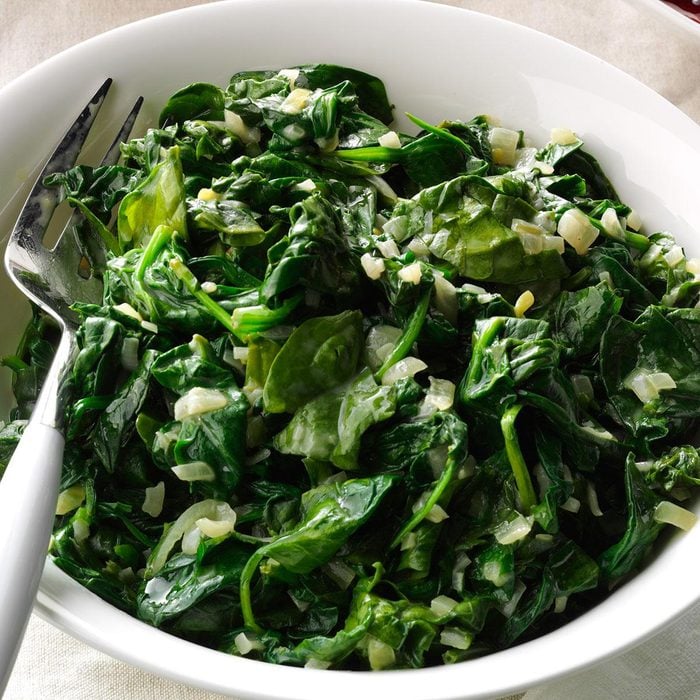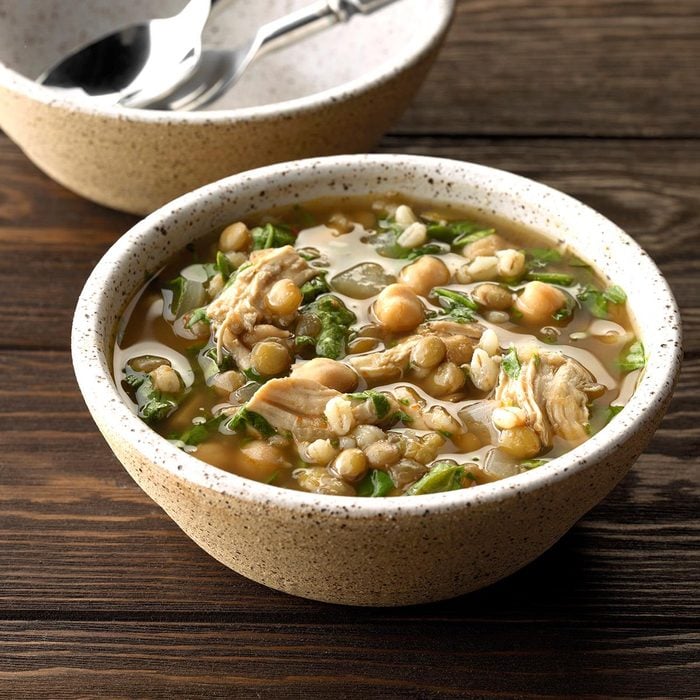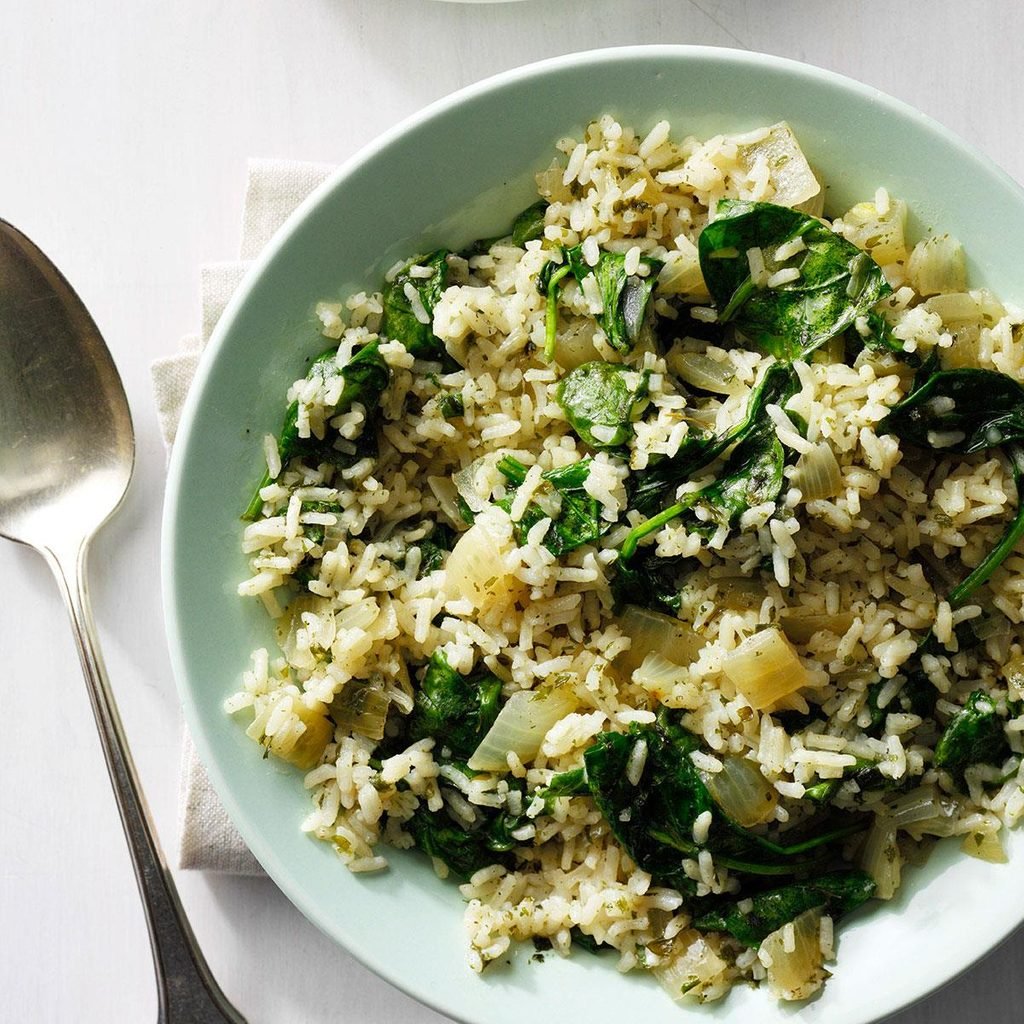Crustless Spinach Quiche
I served this crustless quiche at a church lunch, and I had to laugh when one guy told me how much he disliked vegetables. Many people were surprised by how much they loved this veggie-filled
quiche recipe—and he was one of them! —Melinda Calverley, Janesville, Wisconsin
Go to Recipe
Bacon and Spinach PizzaOur go-to pizza is a snap to make using packaged pizza crust and ready-to-serve bacon. The kids don't even mind the spinach on top! —Annette Riva, Naperville, Illinois
Spinach BurritosI made up this recipe a couple of years ago after trying a similar dish in a restaurant. Our oldest son tells me these burritos are awesome! It's an added bonus that they're inexpensive and easy to make. —Dolores Zornow, Poynette, Wisconsin
Gnocchi with Spinach and Chicken SausageDinner is easy when I can use ingredients typically found in my fridge and pantry. —Laura Miller, Lake Ann, Michigan
Spinach QuesadillasMy family gave these cheesy quesadillas oohs and aahs. Remove the spinach from the heat as soon as it wilts so it keeps a little bit of crunch. —Pam Kaiser, Mansfield, Missouri
Turkey MeatballsWe make our turkey meatballs with spinach to ensure they turn out tender, juicy and moist. They freeze beautifully, so don’t be afraid to make a double (or triple) batch.
Bow Tie & Spinach SaladWith pasta salad, it’s easy to change up ingredients. We like to add grilled chicken and pine nuts, and sometimes we substitute black beans for the garbanzo beans. —Julie Kirkpatrick, Billings, Montana
Lime Coconut Smoothie BowlThis Key lime and coconut smoothie bowl is the most refreshing thing on the planet! —Madeline Butler, Denver, Colorado
Spinach Dip-Stuffed MushroomsI use a melon baller to hollow out the mushroom caps and make them easier to stuff. The apps fit neatly into muffin tins or a deviled egg tray for traveling. —Ashley Pierce, Brantford, Ontario
Spinach Tortellini SoupSpinach tortellini soup comes to the rescue when you're staring down dinnertime and haven't a clue what to make! This filling, flavorful 20-minute soup recipe will please the whole family.
Sausage & Spinach CalzonesThese comforting calzones are perfect for quick meals—or even midnight snacks. My nurse co-workers always ask me to make them when it's my turn to bring in lunch. —Kourtney Williams, Mechanicsville, Virginia
Beef & Spinach Lo MeinIf you like a good stir-fry, this beef and spinach lo mein will definitely satisfy. I discovered the recipe at an international luncheon, and it's now a favorite go-to meal. —Denise Patterson, Bainbridge, Ohio
Turkey Sausage-Stuffed Acorn SquashFinding healthy recipes the family will eat is a challenge. This elegant squash is one we love, and it works with pork or chicken sausage, too. —Melissa Pelkey Hass, Waleska, Georgia
Artichoke Florentine PastaPasta loaded with artichokes and creamy cheese is everything a Sunday dinner should be: rich, tasty and memorable. Add cooked chicken, shrimp or crab if you like. —Nancy Beckman, Helena, Montana
Cheesy SpinachMy daughter often serves this cheese and spinach blend at church suppers. Even people who don't usually eat spinach like this flavorful dish once they try it. There are never any leftovers. —Frances Moore, Decatur, Illinois
Whole Wheat Waffles with Chicken & Spinach SauceOn a business trip years ago, I got the idea for waffles with chicken and spinach. When I serve it, people go back for seconds, even thirds. —Vicki Melies, Elkhorn, Nebraska
Rainbow QuicheWith plenty of veggies and a creamy egg-cheese filling, this tasty quiche gets rave reviews every time I make it! —Lilith Fury, Adena, Ohio
Cheesy Potato Egg BakeI whipped up this cozy egg bake with potato crowns for an easy “brinner.” Use add-ins you like – sweet peppers, onions, broccoli, carrots. The possibilities are endless. —Amy Lents, Grand Forks, North Dakota
Bacon-Wrapped Pesto Pork TenderloinI love to serve this family-favorite tenderloin—maybe because of the compliments that come with it! When the weather warms up, we grill it instead. —Megan Riofski, Frankfort, Illinois
Spinach and Artichoke PizzaMy from-scratch pizza has a whole wheat crust flavored with beer. Top it with spinach, artichoke hearts and tomatoes, then add chicken or ham and fresh basil if you want to include meat. —Raymonde Bourgeois, Swastika, Ontario
Loaded Avocado BLTMy husband invented this twist on a bacon, lettuce and tomato sandwich. I like to make it with extra slices of bacon; if you want, you can leave the Gorgonzola cheese out of the avocado spread. —Lori Grant, Kingsport, Tennessee
Sausage and Lentil SoupSpicy sausage and chicken broth flavor the milder lentils and beans in this sausage and lentil soup recipe. Tomatoes and spinach add color while goat cheese tops it off with a bit of tanginess.
Garlicky Chicken DinnerFlavorful bone-in chicken is enhanced by herbs, lemon and hearty vegetables in this savory meal-in-one entree. —Shannon Norris, Cudahy, Wisconsin
Gorgonzola Shrimp PastaThis creamy pasta dish is so quick and easy to make. It's perfect for weeknights, but feels special enough for company. —Robin Haas, Hyde Park, Massachusetts
Power Berry Smoothie BowlWhile you can't taste the spinach in these smoothies, you'll get all its nutrients along with big berry flavor. —Christine Hair, Odessa, Florida
Cobb Salad SubWhen we need a quick meal to share, we turn Cobb salad into a sandwich masterpiece. Sometimes I substitute tortillas for the bread and make wraps instead. —Kimberly Grusendorf, Medina, Ohio
Tomato & Garlic Butter Bean DinnerOn the days I get home late and just want a warm meal, I stir together tomatoes, garlic and butter beans. Ladle it over noodles if you're in the mood for pasta. —Jessica Meyers, Austin, Texas
Also, check if there is a difference between
butter beans vs lima beans and make grocery shopping a little less confusing.
Spinach-Egg Breakfast PizzasI like my food pretty, and this breakfast pizza is eye-popping. Bring it to the table with a bowl of berries or grapes and café au lait. —Lily Julow, Lawrenceville, Georgia
Creamed Spinach & Pearl OnionsWhen I was a culinary student, this creamy dish wowed me, and I don't even like spinach. This side is a keeper! —Chelsea Puchel, Pickens, South Carolina
Sausage-Topped White PizzaI love cooking, and I learned from Nana and Mom. Pizza is easily one of my favorite dishes to prepare. I switched up this recipe to make it my own. —Tracy Brown, River Edge, New Jersey
Arborio Rice and White Bean SoupSoup is the ultimate comfort food. This hearty, satisfying soup with arborio rice is low in fat and comes together in less than 30 minutes. —Deanna McDonald, Grand Rapids, Michigan
Polenta with Mushrooms and SpinachAs a vegetarian, I love coming up with new dishes that non-vegetarians will enjoy (and not miss the meat). This polenta with mushrooms and spinach recipe is so good, everyone always asks for the recipe. —Marcy Delpome, Stanhope, New Jersey
Shrimp Fra DiavoloLove red sauce? You've got to try fra diavolo: a spicy, garlicky recipe that just might be the perfect tomato sauce.
Frittata FlorentineMy family is all about brunchy meals like this gorgeous Italian omelet. Lucky for us, it’s loaded with ingredients we tend to have at the ready. —Jenny Flake, Newport Beach, California
Flank Steak PinwheelsThe secret to these pretty flank steak pinwheels lies in their butterfly treatment. Because the steaks are flattened, marinade isn’t need. Instead, they’re filled with a colorful stuffing of red pepper and spinach and draped with a flavorful, homemade blue cheese sauce. —Taste of Home Test Kitchen
Mushroom and Spinach SauteMushrooms and spinach make a super fast combination that’s perfect for two. And it’s easy to double or triple for a crowd. —Pauline Howard, Lago Vista, Texas
Creamy Prosciutto PastaI'm always looking for dinners that I can put together quickly. I re-created a favorite pasta dish from an Italian restaurant by using grocery store convenience products. Add crusty bread and a salad for a complete meal. —Christine Ward, Austin, Texas
Chicken Gnocchi Pesto SoupAfter tasting a similar soup at a restaurant, I created this quick and tasty version. It’s rich and creamy, and couldn’t be easier to make! —Deanna Smith, Des Moines, Iowa
Modern Tuna CasseroleTuna casserole was my favorite as a kid, and I found myself craving it as an adult. I reconfigured the recipe to include more vegetables, and the result is perfection. —Rebecca Blanton, St. Helena, California
Slow-Cooker Spinach Bean SoupThis navy bean soup is heartwarming comfort food at its best. It's my signature soup that I make for my family and friends. The bright red and green of the peppers and spinach give it a suitably seasonal look. —Barbara Shay, Pasadena, California
Hot Spinach Spread with Pita ChipsWarm and cheesy, this spread is absolutely scrumptious served on toasted pita wedges. Its colorful appearance makes a stunning addition to any buffet. —Teresa Emanuel, Smithville, Missouri
Salmon with Spinach SauceYou won't have to fish for compliments with this tasty recipe. Poaching is a quick and healthy way to prepare an entree as delicate as fish, keeping it moist and tender while cooking. And the flavorful spinach sauce adds a pretty green accent to the pink salmon. —Taste of Home Test Kitchen
Spinach Feta TurnoversThese quick and easy turnovers are a favorite with my wife, who says they are delicious and melt in your mouth. —David Baruch, Weston, Florida
Spinach and Feta Stuffed ChickenMy chicken bundles are simple, clean and comforting. Serve them with wild rice and green beans for one of our favorite meals. —Jim Knepper, Mount Holly Springs, Pennsylvania
Crunchy Spinach CasseroleOur holidays would not be the same without this family tradition. My mother made it every Thanksgiving when I was growing up; now I make it every Christmas as well, and my children and grandchildren absolutely love it! We triple the recipe because the kids can't get enough. —Sharon Scaletta, Johnstown, Pennsylvania
Lemon Orzo SaladThis tasty lemon orzo salad recipe is just the thing you’ll want to have on hand, whether you’re in need of a quick meal or a side dish everyone will love.
Spinach Pork TenderloinStuffed with fresh spinach and artichoke hearts, these pork slices look fancy enough for guests. —Linda Rae Lee of San Francisco, California.
Potato Kielbasa SkilletNo need to hunt through kielbasa and potato recipes, this smoky take steals the show as a hearty home-style, all-in-one meal. It's especially perfect on those cold late fall and early winter nights. —Taste of Home Test Kitchen, Milwaukee, Wisconsin
Spinach & Bacon Salad with PeachesPeaches and bacon? Oh, yeah. I made this family favorite for a big summer party. It was so easy to prep the parts separately, then toss it all together right before chow time. —Megan Riofski, Frankfort, Illinois
Spinach LasagnaLooking for a hearty vegetarian main course? This spinach lasagna recipe features layers of noodles stuffed with tender spinach and a creamy, cheesy filling.
Garden RisottoWith asparagus, spinach and peas, this simple side adds spectacular flavor and tons of health benefits from green veggies. Add some Parmesan cheese, and you've got one delectable dish! —Kendra Doss, Kansas City, Missouri
Spinach & Chicken Phyllo PieFor a brunch showstopper, we make chicken pie with phyllo and spinach. Our kids go for it, too, especially when we serve it with a minty fruit salad. —Katie Ferrier Gage, Houston, Texas
Penne Pasta with Ground BeefThis is a hearty but affordable weeknight meal that brings out smiles as you serve it. The strings of melted mozzarella that trail from each spoonful are just a hint of the comforting flavors to come.
Spinach and Mushroom Smothered ChickenChicken breasts stay nice and moist tucked under a blanket of melted cheese. It's extra special to serve but is not tricky to make. —Katrina Wagner, Grain Valley, Missouri
Sausage Spinach TurnoversOne Christmas, I gave these tasty meat pies to our neighbors as gifts instead of sweets—they loved them! The handheld pies make a handy take-along lunch. I freeze the leftovers and reheat them later in the microwave when I need a quick meal. —Vicky Henry
Aurora, Colorado
Sheet-Pan Chicken and VeggiesOur sheet-pan chicken and veggies recipe features herby chicken thighs, roasted red potatoes and spinach in one no-muss, no-fuss dish. The best part: Cleanup is a breeze!
Watermelon and Spinach SaladSummer's the perfect time to toss up this watermelon salad. You'd never expect it, but spinach is awesome here. Eat it and feel cool on even the hottest days. —Marjorie Au, Honolulu, Hawaii
Italian Brunch TorteWe always serve this impressive layered breakfast bake with a salad of mixed greens and tomato wedges. It is one of our most requested dishes and can be served warm or cold. —Danny Diamond, Farmington Hills, Michigan
Creamy Roasted Garlic & Spinach OrzoThis side dish brings instant comfort. I first made it without spinach so my husband and daughter would like it. The next time, I added spinach for the extra health benefits. They still devoured it, so in my book that's a win-win. —Dawn Moore, Warren, Pennsylvania
Almond Strawberry SaladIt's easy to love this pretty salad topped with strawberries and sliced almonds. With just a few ingredients, it's loaded with flavor. —Renae Rossow, Union, Kentucky
Spinach Chicken ManicottiPepper and nutmeg spice up the rich sauce in this hearty chicken and spinach manicotti. I made this for my boyfriend on our first Valentine’s Day. It was a big success—now we're married! —Amy Luce, Dallas, Texas
Parmesan Creamed SpinachThis rich and creamy spinach dish takes minutes to make. If I'm expecting guests, I'll double or triple the recipe. —Leann Ross, San Tan Valley, Arizona
Grandma’s Spinach SaladThis hearty spinach salad with mushrooms is packed with protein and draped in an aromatic celery seed vinaigrette. You can prep a batch and store it in the fridge for quick lunches.
Chicken Thighs with Shallots & SpinachWhat could be better than an entree that comes with its own creamy vegetable side? This healthy supper goes together in no time flat and makes an eye-catching presentation. —Genna Johannes, Wrightstown, Wisconsin
Spinach PestoServe this vibrant pesto on pasta, pizza, sandwiches and more. If you don't have fresh oregano on hand, you can omit it. —Susan Westerfield, Albuquerque, New Mexico. Here are our favorite
spinach pesto recipes.
Pasta Fagioli SoupFilled with fresh turkey sausage, beans and pasta, pasta fagioli soup is a powerhouse of nutrients and flavor.
Creamy Curried ChickenThis is a big hit in our house. My young son and daughter gobble it up. With its irresistible blend of curry and sweet coconut milk, it’ll become a favorite with your family, too. —Tracy Simiele, Chardon, Oh
Creamy Chicken Gnocchi SoupI tasted a similar soup at Olive Garden and wanted to see if I could re-create it myself at home. Here's the delicious result! It's wonderful on a chilly evening. —Jaclynn Robinson, Shingletown, California
One-Pot Spinach Beef SoupMy idea of a winning weeknight meal is this beefy soup simmering in one big pot. Grate some Parmesan and pass the saltines. —Julie Davis, Jacksonville, Florida
Spicy Beef Stir FrySpice up your dinner rotation with our 30-minute beef stir fry recipe. Tender sirloin and crisp veggies meet a fiery coconut-lime sauce for a quick and delicious meal any night of the week.
Ravioli with Apple Chicken SausageI wanted the perfect sauce for squash ravioli. The wait is over. Here’s what works: spinach, sausage, maple syrup and pumpkin pie spice in one happy saucepan. —Mary Brodeur, Millbury, Massachusetts
Spinach & Gouda Stuffed Pork CutletsThis started as a restaurant copycat dish at home. Cheese just oozes out of the center, and mustard lends a lot of flavor. —Joan Oakland, Troy, Montanta
Spinach ‘n’ Broccoli EnchiladasI like to top this wonderful meatless meal with lettuce and serve it with extra picante sauce. It's quick, easy, filled with fresh flavor and definitely satisfying! —Lesley Tragesser, Charleston, Missouri
Blueberry SaladA winning combination of spinach, berries and cheese, this blueberry salad is simple enough to make whenever the craving hits. If you keep the dressing in a separate container and have access to a fridge, it's ideal for packed lunches.
Christina's Italian Wedding SoupI'm big on soups with tiny meatballs and pasta. I double the meatballs, poach them in the broth, remove half and freeze them for another time. —Christina Hitchcock, Madison Township, Pennsylvania
Lemon Chicken OrzoLemon chicken orzo is a one-pot wonder. It's easy enough to make for a weeknight meal, but fancy enough to serve for guests. Customize it with different pasta shapes and your favorite vegetables.
Spinach-Parm CasseroleFor those who ignore Popeye and won’t eat their spinach, I find that spinach with garlicky butter and Parmesan helps change their minds. —Judy Batson, Tampa, Florida
Creamy Parmesan Spinach BakeMy creamy, comforting side dish wonderfully rounds out any holiday dinner. Just a little of this rich casserole goes a long way. —Jennifer Bley, Austin, Texas
Spinach TurnoversThe flaky cream cheese pastry adds sensational texture to these hot appetizers—and just wait until you taste the wonderful filling. I usually fix a double batch and freeze some to have on hand in case unexpected guests drop by. — Jean von Bereghy, Oconomowoc, Wisconsin
Spinach-Pesto White PizzaWhen my kids were really small, they were reluctant to eat their veggies and I had to get creative. I figured that because pesto is already green, it would be the perfect place for some spinach. The pizza was a big hit. —Janet Burbach, North Platte, Nebraska
Creamed Spinach with ParmesanCooked spinach makes a perfect accompaniment to many entrees, especially salmon.—Taste of Home Test Kitchen
Spiced-Up Healthy Soup“This has been a hit with family and friends. It’s spicy, low-fat and filled with good-for-you ingredients.” Diane Tayman — Dixon, Illinois
Spinach Pie ParmaFor a hearty pie with a lovely Italian flavor, try this recipe. Spinach has never tasted so good! —Nancy Reichert, Thomasville, Georgia
Spinach Feta Strata A friend shared this strata recipe with me, and my family loved it the first time I made it. It's become a favorite way to eat spinach. —Pat Lane, Pullman, Washington
Spinach RiceI like to serve this Greek-style rice dish alongside steaks with mushrooms. It makes an elegant side that can be doubled for guests. —Jeanette Cakouros, Brunswick, Maine
Shrimp ‘n’ Spinach RisottoI enjoy concocting new, healthy recipes and spinach is one of the few vegetables that my husband will eat. My creamy risotto makes a great side dish, but doubles as a meal-in-one as well. —Jennifer Neilsen, Williamston, North Carolina
